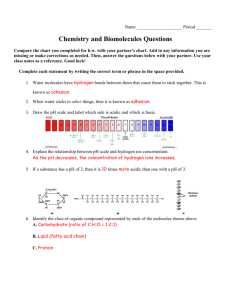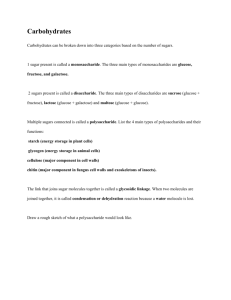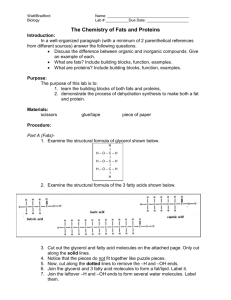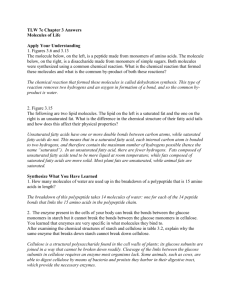chapters 4 and 5
advertisement
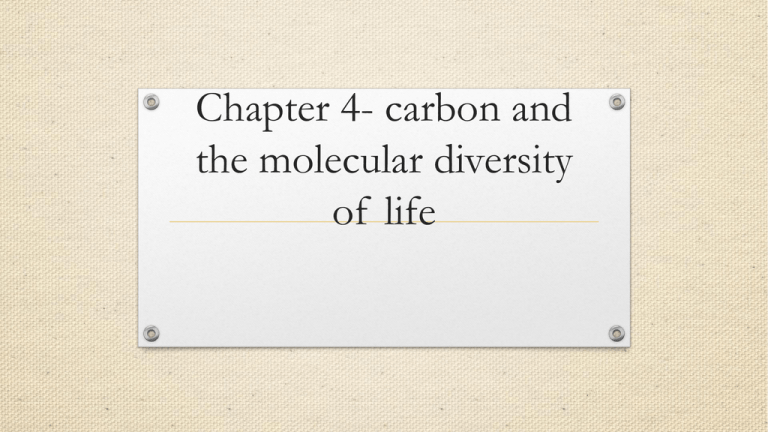
Chapter 4- carbon and the molecular diversity of life Objective • SWBAT explain the subcomponents of biological molecules and that their sequences determine the properties of that molecule Homework 1. Diagram pages 64 and 65. For all 7 chemical groups, include the structure, name of compounds, examples, and list of functional properties. 2. Read Chapter 5 pp 68-85 Overview: Carbon: The Backbone of Life Proteins • Living organisms consist mostly of carbon-based compounds • Proteins, DNA, carbohydrates, and other molecules that distinguish living matter are all composed of carbon compounds Carbohydrates Lipids Nucleic Acids Organic Molecules and the Origin of Life on Earth • Stanley Miller’s classic experiment demonstrated the abiotic synthesis of organic compounds • Experiments support the idea that abiotic synthesis of organic compounds, perhaps near volcanoes, could have been a stage in the origin of life Concept 4.2: Carbon atoms can form diverse molecules by bonding to four other atoms • Electron configuration is the key to an atom’s characteristics • Electron configuration determines the kinds and number of bonds an atom will form with other atoms The Formation of Bonds with Carbon • With four valence electrons, carbon can form four covalent bonds with a variety of atoms • This ability makes large, complex molecules possible Figure 4.3 Name and Comment Molecular Formula (a) Methane CH4 (b) Ethane C2H6 (c) Ethene (ethylene) C2H4 Structural Formula Ball-andStick Model Space-Filling Model • The electron configuration of carbon gives it covalent compatibility with many different elements • The valences of carbon and its most frequent partners (hydrogen, oxygen, and nitrogen) are the “building code” that governs the architecture of living molecules CHON are bonded buddies Covalent bond: type of strong chemical bond in which two atoms share one or more pairs of valence electrons Valence: bonding capacity of a given atom; usually equals # unpaired electrons req’d to complete atom’s valence (outermost) shell Figure 4.4 Hydrogen (valence 1) Oxygen (valence 2) Nitrogen (valence 3) Carbon (valence 4) Figure 4.UN01 Urea Molecular Diversity Arising from Carbon Skeleton Variation • Carbon chains form the skeletons of most organic molecules • Carbon chains vary in length and shape Animation: Carbon Skeletons Right-click slide/select “Play” Figure 4.5 (c) Double bond position (a) Length Ethane Propane (b) Branching Butane 1-Butene 2-Butene (d) Presence of rings 2-Methylpropane (isobutane) Cyclohexane Benzene Hydrocarbons • Hydrocarbons are organic molecules consisting of only carbon and hydrogen • Many organic molecules, such as fats, have hydrocarbon components • Hydrocarbons can undergo reactions that release a large amount of energy Figure 4.6 Nucleus Fat droplets 10 m (a) Part of a human adipose cell (b) A fat molecule Isomers • Isomers are compounds with the same molecular formula but different structures and properties • Structural isomers have different covalent arrangements of their atoms • Cis-trans isomers have the same covalent bonds but differ in spatial arrangements • Enantiomers are isomers that are mirror images of each other Animation: Isomers Right-click slide / select “Play” Figure 4.7 (a) Structural isomers (b) Cis-trans isomers cis isomer: The two Xs are on the same side. trans isomer: The two Xs are on opposite sides. (c) Enantiomers CO2H CO2H H NH2 CH3 L isomer NH2 H CH3 D isomer • Enantiomers are important in the pharmaceutical industry • Two enantiomers of a drug may have different effects • Usually only one isomer is biologically active • Differing effects of enantiomers demonstrate that organisms are sensitive to even subtle variations in molecules Figure 4.8 Drug Condition Ibuprofen Pain; inflammation Albuterol Effective Enantiomer Ineffective Enantiomer S-Ibuprofen R-Ibuprofen R-Albuterol S-Albuterol Asthma The Miller-Urey experiment, shown below, a) showed that the conditions of early Earth were inhospitable to life b) demonstrated that amino acids and other organic molecules form under conditions that may have existed on Earth before life began c) proved that life could originate from inorganic chemicals d) both B and C The Miller-Urey experiment, shown below, a) showed that the conditions of early Earth were inhospitable to life b) demonstrated that amino acids and other organic molecules form under conditions that may have existed on Earth before life began c) proved that life could originate from inorganic chemicals d) both B and C Concept 4.3: A few chemical groups are key to the functioning of biological molecules • Distinctive properties of organic molecules depend on the carbon skeleton and on the molecular components attached to it • A number of characteristic groups can replace the hydrogens attached to skeletons of organic molecules The Chemical Groups Most Important in the Processes of Life • Functional groups are the components of organic molecules that are most commonly involved in chemical reactions • The number and arrangement of functional groups give each molecule its unique properties Figure 4.UN02 Estradiol Testosterone • The seven functional groups that are most important in the chemistry of life: Need to know!!!! • • • • • • • Hydroxyl group Carbonyl group Carboxyl group Amino group Sulfhydryl group Phosphate group Methyl group Functional Groups (Pg. 64 & 65) • Seven groups to know and identify: -Hydroxyl (OH) Alcohols (not hydroxide) -Carbonyl (C=O) Aldehyde or Ketone -Carboxyl (COOH) weak acids -Amino (NH2) Proteins -Methyl (CH3)**Nonpolar hydrocarbon -Phosphate (PO4) Nucleic acids: DNA & RNA -Sulfhydryl (SH) Protein Structures Figure 4.9-a CHEMICAL GROUP Hydroxyl Carbonyl Carboxyl STRUCTURE (may be written HO—) NAME OF COMPOUND Alcohols (Their specific names usually end in -ol.) Ketones if the carbonyl group is within a carbon skeleton Carboxylic acids, or organic acids Aldehydes if the carbonyl group is at the end of the carbon skeleton EXAMPLE Ethanol Acetone Acetic acid Propanal FUNCTIONAL PROPERTIES • Is polar as a result of the electrons spending more time near the electronegative oxygen atom. • Can form hydrogen bonds with water molecules, helping dissolve organic compounds such as sugars. • A ketone and an aldehyde may be structural isomers with different properties, as is the case for acetone and propanal. • Ketone and aldehyde groups are also found in sugars, giving rise to two major groups of sugars: ketoses (containing ketone groups) and aldoses (containing aldehyde groups). • Acts as an acid; can donate an H+ because the covalent bond between oxygen and hydrogen is so polar: Nonionized Ionized • Found in cells in the ionized form with a charge of 1 and called a carboxylate ion. Figure 4.9-b Amino Sulfhydryl Phosphate Methyl (may be written HS—) Amines Organic phosphates Thiols Cysteine Glycine • Acts as a base; can pick up an H+ from the surrounding solution (water, in living organisms): Nonionized Ionized • Found in cells in the ionized form with a charge of 1+. Glycerol phosphate • Two sulfhydryl groups can react, forming a covalent bond. This “cross-linking” helps stabilize protein structure. • Contributes negative charge to the molecule of which it is a part (2– when at the end of a molecule, as above; 1– when located internally in a chain of phosphates). • Cross-linking of cysteines in hair proteins maintains the curliness or straightness of hair. Straight hair can be “permanently” curled by shaping it around curlers and then breaking and re-forming the cross-linking bonds. • Molecules containing phosphate groups have the potential to react with water, releasing energy. Methylated compounds 5-Methyl cytidine • Addition of a methyl group to DNA, or to molecules bound to DNA, affects the expression of genes. • Arrangement of methyl groups in male and female sex hormones affects their shape and function. Is this molecule soluble in water? a) yes b) no Is this molecule soluble in water? a) yes b) no ATP: An Important Source of Energy for Cellular Processes • One phosphate molecule, adenosine triphosphate (ATP), is the primary energy-transferring molecule in the cell • ATP consists of an organic molecule called adenosine attached to a string of three phosphate groups Figure 4. UN04 Adenosine Figure 4. UN05 Reacts with H2O Adenosine Adenosine ATP Inorganic phosphate ADP Energy What functional group is commonly used in cells to transfer energy from one organic molecule to another? •a) carboxyl •b) sulfhydryl •c) hydroxyl •d) phosphate •e) amino What functional group is commonly used in cells to transfer energy from one organic molecule to another? •a) carboxyl •b) sulfhydryl •c) hydroxyl •d) phosphate •e) amino Chapter 5- The Structure and Function of Large Biological Molecules The four major macromolecules 1. 2. 3. 4. Carbohydrates Lipids Proteins Nucleic Acids Macromolecules are large molecules composed of thousands of covalently connected atoms Concept 5.1: Macromolecules are polymers, built from monomers • A polymer is a long molecule consisting of many similar building blocks • These small building-block molecules are called monomers • Three of the four classes of life’s organic molecules are polymers • Carbohydrates • Proteins • Nucleic acids The Synthesis and Breakdown of Polymers • A dehydration reaction occurs when two monomers bond together through the loss of a water molecule (lipids exempt!!!) • Polymers are disassembled to monomers by hydrolysis, a reaction that is essentially the reverse of the dehydration reaction Animation: Polymers Right-click slide / select “Play” Figure 5.2 (a) Dehydration reaction: synthesizing a polymer 1 2 3 Short polymer Unlinked monomer Dehydration removes a water molecule, forming a new bond. 1 2 3 4 Longer polymer (b) Hydrolysis: breaking down a polymer 1 2 3 Hydrolysis adds a water molecule, breaking a bond. 1 2 3 4 Concept 5.2: Carbohydrates serve as fuel and building material • Carbohydrates include sugars and the polymers of sugars • The simplest carbohydrates are monosaccharides, or single sugars • Carbohydrate macromolecules are polysaccharides, polymers composed of many sugar building blocks Sugars • Monosaccharides have molecular formulas that are usually multiples of CH2O • Glucose (C6H12O6) is the most common monosaccharide • Monosaccharides are classified by : • The location of the carbonyl group (as aldose or ketose) • The number of carbons in the carbon skeleton Figure 5.3 Aldoses (Aldehyde Sugars) Ketoses (Ketone Sugars) Trioses: 3-carbon sugars (C3H6O3) Glyceraldehyde Dihydroxyacetone Pentoses: 5-carbon sugars (C5H10O5) Ribose Ribulose Hexoses: 6-carbon sugars (C6H12O6) Glucose Galactose Fructose Figure 5.4 1 2 6 6 5 5 3 4 4 5 1 3 2 4 1 3 2 6 (a) Linear and ring forms aqueous solutions many sugars form rings • Monosaccharides serve as a major fuel for cells and as raw material for building molecules 6 5 4 1 3 • Though often drawn as linear skeletons, in 2 (b) Abbreviated ring structure • A disaccharide is formed when a dehydration reaction joins two monosaccharides • This covalent bond is called a glycosidic linkage Animation: Disaccharide Right-click slide / select “Play” Figure 5.5 1–4 glycosidic 1 linkage 4 Glucose Glucose Maltose (a) Dehydration reaction in the synthesis of maltose 1–2 glycosidic 1 linkage 2 Glucose Fructose (b) Dehydration reaction in the synthesis of sucrose Sucrose Which group of large biological molecules is not synthesized via dehydration reactions? a) b) c) d) polysaccharides lipids proteins nucleic acids Which group of large biological molecules is not synthesized via dehydration reactions? a) b) c) d) polysaccharides lipids proteins nucleic acids Polysaccharides • Polysaccharides, the polymers of sugars, have storage and structural roles • The structure and function of a polysaccharide are determined by its sugar monomers and the positions of glycosidic linkages Storage Polysaccharides • Starch, a storage polysaccharide of plants, consists entirely of glucose monomers • Plants store surplus starch as granules within chloroplasts and other plastids • The simplest form of starch is amylose Figure 5.6 Chloroplast Starch granules Amylopectin Amylose (a) Starch: 1 m a plant polysaccharide Mitochondria Glycogen granules Glycogen (b) Glycogen: 0.5 m an animal polysaccharide • Glycogen is a storage polysaccharide in animals • Humans and other vertebrates store glycogen mainly in liver and muscle cells Figure 5.6b Mitochondria Glycogen granules 0.5 m Structural Polysaccharides • The polysaccharide cellulose is a major component of the tough wall of plant cells • Like starch, cellulose is a polymer of glucose, but the glycosidic linkages differ • The difference is based on two ring forms for glucose: alpha () and beta () Animation: Polysaccharides Right-click slide / select “Play” Figure 5.7 (a) and glucose ring structures 4 1 4 Glucose Glucose 1 4 (b) Starch: 1–4 linkage of glucose monomers 1 1 4 (c) Cellulose: 1–4 linkage of glucose monomers • Polymers with glucose are helical • Polymers with glucose are straight • In straight structures, H atoms on one strand can bond with OH groups on other strands • Parallel cellulose molecules held together this way are grouped into microfibrils, which form strong building materials for plants Figure 5.8 Cellulose microfibrils in a plant cell wall Cell wall Microfibril 10 m 0.5 m Cellulose molecules Glucose monomer • Enzymes that digest starch by hydrolyzing linkages can’t hydrolyze linkages in cellulose • Cellulose in human food passes through the digestive tract as insoluble fiber • Some microbes use enzymes to digest cellulose • Many herbivores, from cows to termites, have symbiotic relationships with these microbes • Chitin, another structural polysaccharide, is found in the exoskeleton of arthropods • Chitin also provides structural support for the cell walls of many fungi Figure 5.9 The structure of the chitin monomer Chitin forms the exoskeleton of arthropods. Chitin is used to make a strong and flexible surgical thread that decomposes after the wound or incision heals. Figure 5.9a Chitin forms the exoskeleton of arthropods. Figure 5.9b Chitin is used to make a strong and flexible surgical thread that decomposes after the wound or incision heals. Concept 5.3: Lipids are a diverse group of hydrophobic molecules • Lipids are the one class of large biological molecules that do not form polymers • The unifying feature of lipids is having little or no affinity for water • Lipids are hydrophobic because they consist mostly of hydrocarbons, which form nonpolar covalent bonds • The most biologically important lipids are fats, phospholipids, and steroids Fats • Fats are constructed from two types of smaller molecules: glycerol and fatty acids • Glycerol is a three-carbon alcohol with a hydroxyl group attached to each carbon • A fatty acid consists of a carboxyl group attached to a long carbon skeleton Figure 5.10 Fatty acid (in this case, palmitic acid) Glycerol (a) One of three dehydration reactions in the synthesis of a fat Ester linkage (b) Fat molecule (triacylglycerol) Figure 5.10a Fatty acid (in this case, palmitic acid) Glycerol (a) One of three dehydration reactions in the synthesis of a fat • Fats separate from water because water molecules form hydrogen bonds with each other and exclude the fats • In a fat, three fatty acids are joined to glycerol by an ester linkage, creating a triacylglycerol, or triglyceride Figure 5.10b Ester linkage (b) Fat molecule (triacylglycerol) • Fatty acids vary in length (number of carbons) and in the number and locations of double bonds • Saturated fatty acids have the maximum number of hydrogen atoms possible and no double bonds • Unsaturated fatty acids have one or more double bonds Animation: Fats Right-click slide / select “Play” Figure 5.11 (a) Saturated fat Structural formula of a saturated fat molecule Space-filling model of stearic acid, a saturated fatty acid (b) Unsaturated fat Structural formula of an unsaturated fat molecule Space-filling model of oleic acid, an unsaturated fatty acid Cis double bond causes bending. Figure 5.11a (a) Saturated fat Structural formula of a saturated fat molecule Space-filling model of stearic acid, a saturated fatty acid Figure 5.11b (b) Unsaturated fat Structural formula of an unsaturated fat molecule Space-filling model of oleic acid, an unsaturated fatty acid Cis double bond causes bending. Figure 5.11c Figure 5.11d • Fats made from saturated fatty acids are called saturated fats, and are solid at room temperature • Most animal fats are saturated • Fats made from unsaturated fatty acids are called unsaturated fats or oils, and are liquid at room temperature • Plant fats and fish fats are usually unsaturated • A diet rich in saturated fats may contribute to cardiovascular disease through plaque deposits • Hydrogenation is the process of converting unsaturated fats to saturated fats by adding hydrogen • Hydrogenating vegetable oils also creates unsaturated fats with trans double bonds • These trans fats may contribute more than saturated fats to cardiovascular disease • Certain unsaturated fatty acids are not synthesized in the human body • These must be supplied in the diet • These essential fatty acids include the omega-3 fatty acids, required for normal growth, and thought to provide protection against cardiovascular disease • The major function of fats is energy storage • Humans and other mammals store their fat in adipose cells • Adipose tissue also cushions vital organs and insulates the body Phospholipids • In a phospholipid, two fatty acids and a phosphate group are attached to glycerol • The two fatty acid tails are hydrophobic, but the phosphate group and its attachments form a hydrophilic head Hydrophobic tails Hydrophilic head Figure 5.12 Choline Phosphate Glycerol Fatty acids Hydrophilic head Hydrophobic tails (a) Structural formula (b) Space-filling model (c) Phospholipid symbol Hydrophobic tails Hydrophilic head Figure 5.12a (a) Structural formula Choline Phosphate Glycerol Fatty acids (b) Space-filling model • When phospholipids are added to water, they selfassemble into a bilayer, with the hydrophobic tails pointing toward the interior • The structure of phospholipids results in a bilayer arrangement found in cell membranes • Phospholipids are the major component of all cell membranes Figure 5.13 Hydrophilic head Hydrophobic tail WATER WATER Steroids • Steroids are lipids characterized by a carbon skeleton consisting of four fused rings • Cholesterol, an important steroid, is a component in animal cell membranes • Although cholesterol is essential in animals, high levels in the blood may contribute to cardiovascular disease Figure 5.14 Concept 5.4: Proteins include a diversity of structures, resulting in a wide range of functions • Proteins account for more than 50% of the dry mass of most cells • Protein functions include structural support, storage, transport, cellular communications, movement, and defense against foreign substances
